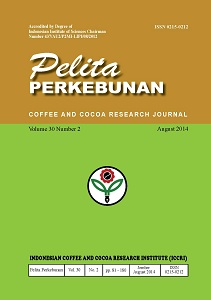Self-Compatibility Crosses of Several Cocoa Clones

Article Sidebar

PDF

Published
Dec 31, 2006
DIMENSION
ALTMETRIC
Main Article Content
Agung Wahyu Susilo
Pusat Penelitian Kopi dan Kakao Indonesia
Abstract
Self compatibility cross in cocoa is a useful criterion in utilizing germplasm collection. Evaluation of self-compatibility crosses on cocoa clones has been carried out in Kaliwining Experimental Station of ICCRI by treating artificial self-pollination. The observed clones were TSH 858, ICS 60, ICS 13, UIT 1, KW 162, KW 165, KW 163, DR 1, DR 2, DRC 16, DRC 15, KKM 22, Na 32, Na 33 and DR 38. Self-compatibility crosses were identified by percentage of fruit set evaluated during 6 consecutive weeks after pollination. The results showed that the percentage of fruit set were significantly different among clones in the range of 0—46.34%. Three groups of compatibility of cocoa clones were identified i.e. first, self-incompatible clones of DR 1, Na 32, Na 33; second, partially self compatible clones of DR 38, TSH 858, ICS 60, ICS 13, UIT 1, KW 162, KW 165, KKM 22; and third, self-compatible clones of DR 2, DRC 16,DRC 15, KW 163. Clones which perform self-incompatible and partially self-compatible furthermore can be used as female parents in the production of hybrids. Key words: self-compatibility, Theobroma cacao, clones.
Article Details
How to Cite
Issue
Section
Articles

This work is licensed under a Creative Commons Attribution-NonCommercial 4.0 International License.
Authors who publish with this journal agree to the following terms:
- Authors retain copyright and grant the journal right of first publication with the work simultaneously licensed under a Creative Commons Attribution License that allows others to share the work with an acknowledgement of the work's authorship and initial publication in this journal.
- Authors are able to enter into separate, additional contractual arrangements for the non-exclusive distribution of the journal's published version of the work (e.g., post it to an institutional repository or publish it in a book), with an acknowledgement of its initial publication in this journal.
- Authors are permitted and encouraged to post their work online (e.g., in institutional repositories or on their website) prior to and during the submission process, as it can lead to productive exchanges, as well as earlier and greater citation of published work (See The Effect of Open Access).
Most read articles by the same author(s)
- Indah Anita Sari, Agung Wahyu Susilo, Development of Selection Criteria on Bean Weight Character of Cocoa (Theobroma cacaoL.) through Path Analysis Approach , Pelita Perkebunan (a Coffee and Cocoa Research Journal): Vol 29 No 3 (2013)
- Agung Wahyu Susilo, Woerjono Mangoendidjojo, Witjaksono ., Relationship Between Pod Characteristics of Some Cocoa Clones (T. cacaoL.) and Their Resistance Response to Cocoa Pod Borer , Pelita Perkebunan (a Coffee and Cocoa Research Journal): Vol 23 No 3 (2007)
